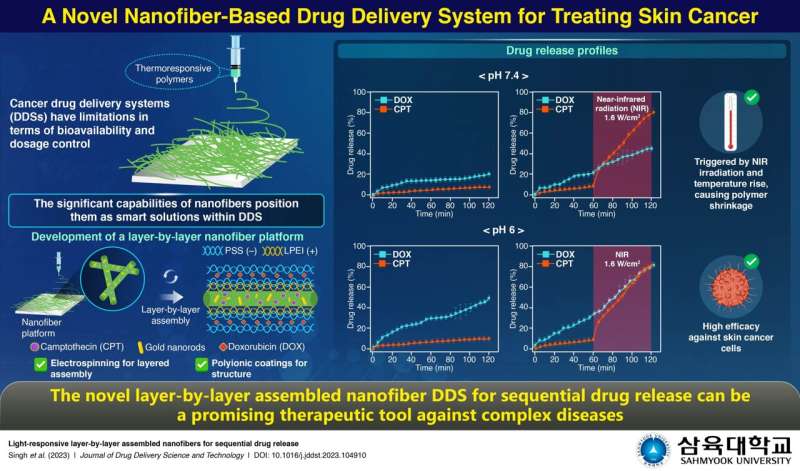
Treating complex diseases such as skin cancer often requires simultaneous administration of multiple anticancer drugs. The delivery of such life-saving therapeutic drugs has evolved with the rise of nanotechnology-based drug carriers. Nanoplatforms offer numerous advantages, including increased bioavailability, lowered dosages, and improved biodistribution.
Now a team of researchers, led by Professor Myoung-Hwan Park from Sahmyook University in South Korea, has developed a light-responsive nanofiber-based novel drug delivery system (DDS) targeting skin cancer. The DDS was studied in a detailed manner, beginning with its synthesis and characterization to its biocompatibility, drug release profile, and efficacy against skin cancer. These research findings are published in the Journal of Drug Delivery Science and Technology.
Explaining the motivation behind the present research, Dr. Park states, “Conventional drugs can be efficiently delivered in a controlled manner through nano-engineered platforms, and such an approach increases the overall effectiveness of the treatment. This approach improves outcomes in cancer drug therapy by ensuring precise delivery at optimal dosages.”
The researchers employed various innovative research methods in developing a smart DDS against skin cancer. Overcoming the solubility barrier of anticancer drugs is crucial and is achieved by coating them with suitable materials for better release. The team created camptothecin (CPT)-contained nanofibers (NFs), using electrospinning. The sequential and controlled drug release from NFs was achieved by using a layer-by-layer assembly process involving poly-ionic coatings to load doxorubicin (DOX).
At pH 7.4, DOX was initially released to a lesser extent, and at pH 6, a substantially larger release was noted. To externally control the drug release profile of CPT, gold nanorods (GNRs) were used. Upon near-infrared (NIR) exposure, the GNRs present in the nanofibers facilitated localized heating, which in turn triggered the sequential and controlled release of CPT by causing the thermosensitive polymer to shrink and swell.
Envisioning the long-term applications of their work, Dr. Park concludes, “Our nanoplatform show[s] significant potential for real-life practical applications in the form of topical drug products for various skin disorders, such as psoriasis, skin cancer, skin wounds, bacterial and fungal infections. Accordingly, the integration of nanofibers with on-demand drug delivery systems can open up new possibilities for drug therapy.”
More information:
Baljinder Singh et al, Light-responsive layer-by-layer assembled nanofibers for sequential drug release, Journal of Drug Delivery Science and Technology (2023). DOI: 10.1016/j.jddst.2023.104910
Provided by
Sahmyook University

READ MORE
Why Did the Salamander Cross the Road?
Each spring as the ground begins to thaw, an epic migration unfolds in New York’s [...]
When can you use fluoride toothpaste on toddlers?
You might think that brushing baby teeth isn’t even really necessary since they fall out [...]
How to Remove Air From Power Steering
Can you even imagine driving without power steering? Barrett-Jackson/Getty Images If steering your car becoming [...]
New method to produce micrometer-scale single crystals in the form of hollow vessels
Researchers at the University of Tsukuba report a new procedure to produce microscopic single crystals [...]
Before Seeing ‘Turning Red,’ Learn These Amazing Red Panda Facts
Red pandas are classified as endangered and are legally protected in their home countries. aaronchengtp [...]
‘Yeti hair’ found in Himalayas is actually from a horse, BBC series reveals
DNA from a supposed Abominable Snowman actually came from a horse, but that doesn’t mean [...]
Tiny motors take a big step forward
Graphical abstract. Credit: ACS Nano (2022). DOI: 10.1021/acsnano.1c09800 Motors are everywhere in our day-to-day lives—from [...]
Meet the Dogs Sniffing Out Whale Poop for Science
Trainer Liz Seely and Tucker head out to search for scat on a research boat. [...]